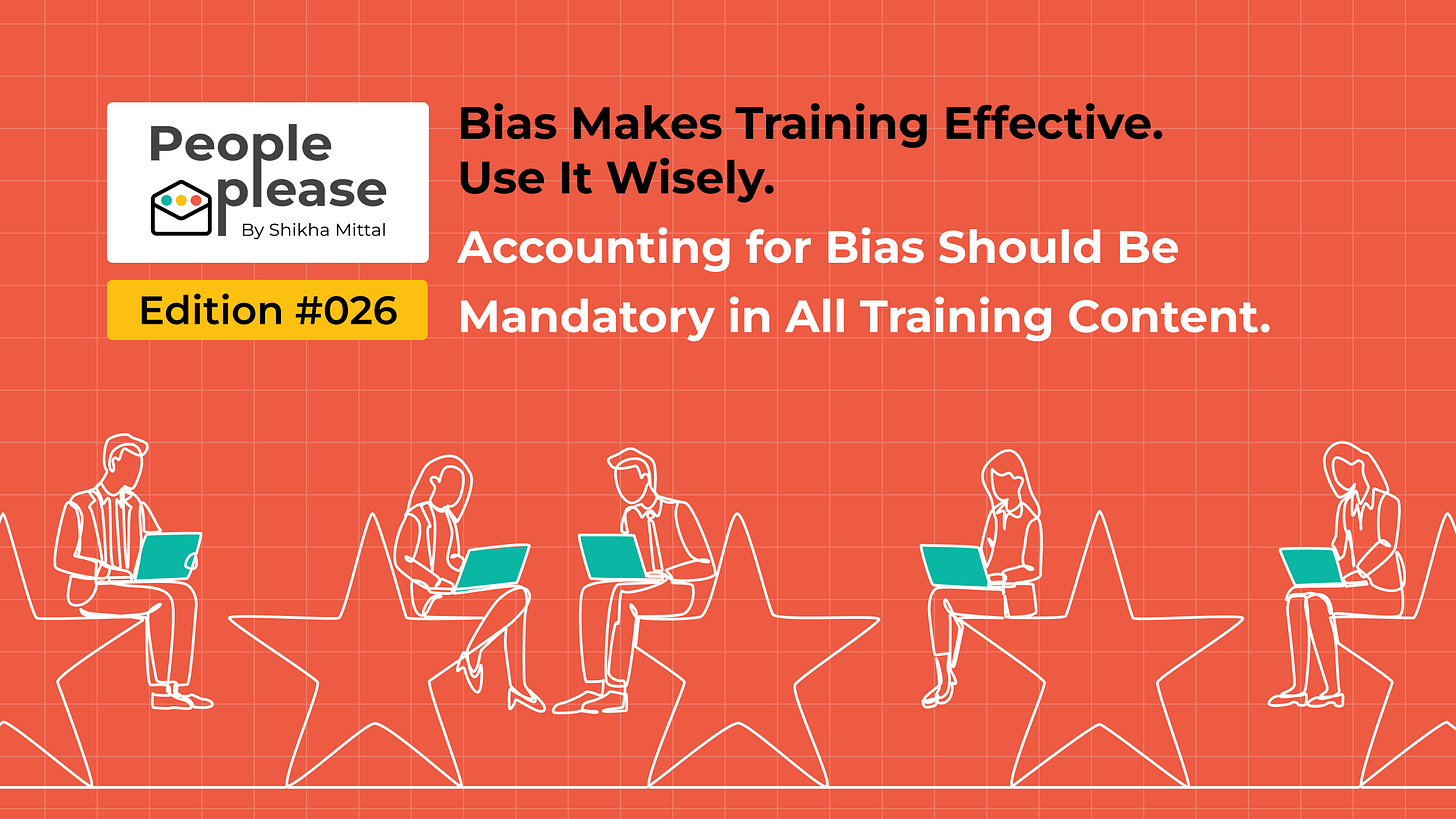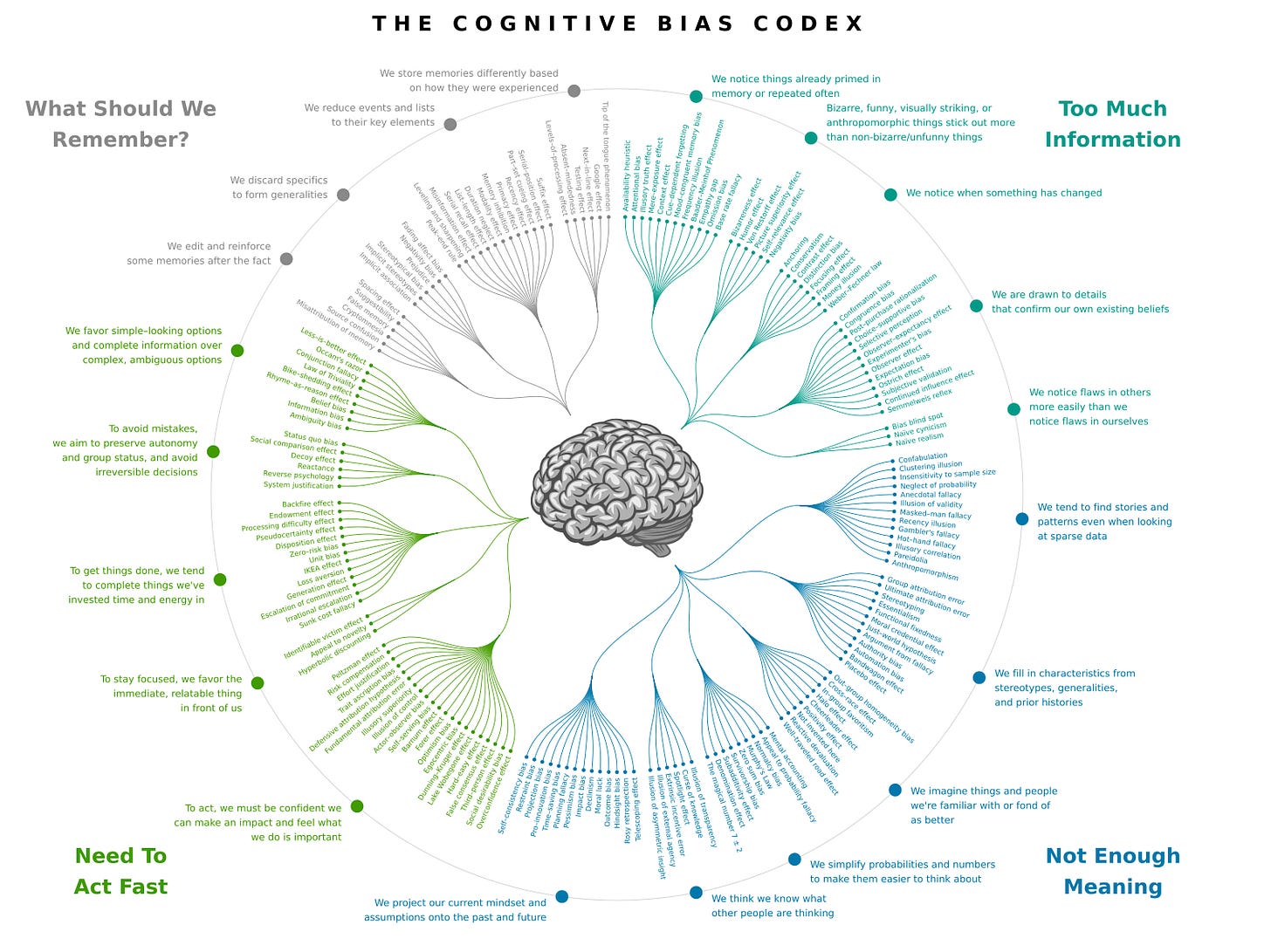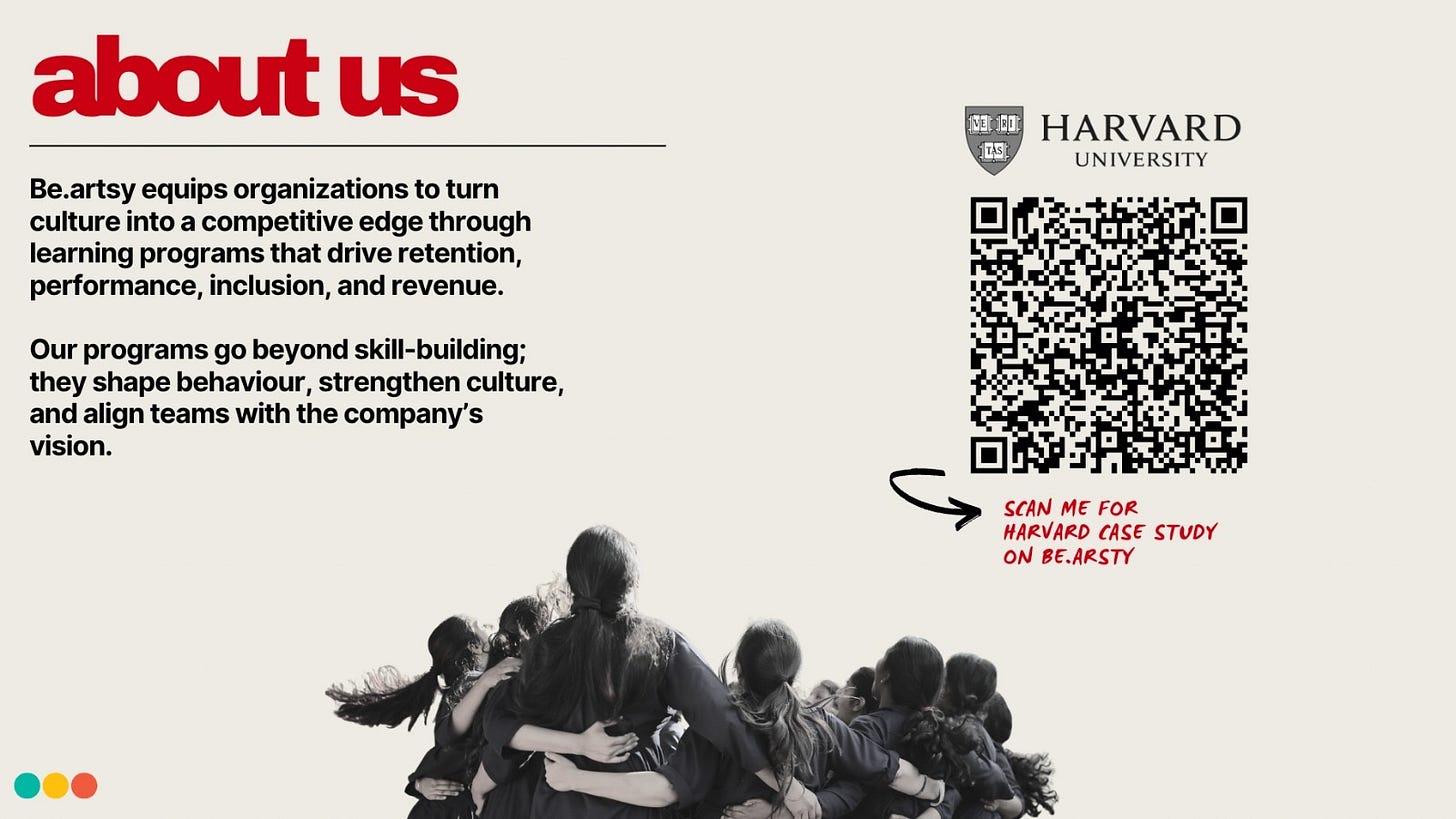Bias Makes Training Effective. Use It Wisely.
Edition 26: Accounting for Bias Should Be Mandatory in All Training Content.
Edition #026: The Hidden Flaw in How We Train
My mission with this newsletter is simple but ambitious: to help 100,000 professionals shift from being People Pleasers to becoming Culture Builders.
One powerful place where culture is built every day, often unconsciously, is through how we train, what content we create, and the perspectives we share in the workplace.
The training industry has evolved dramatically from factory-floor apprenticeships to AI-powered learning platforms. But in all this progress, we’ve overlooked a foundational truth: bias shapes every step of how we design, deliver, and absorb learning.
In this edition, we zoom out to trace the global history of training and zoom in to explore what’s been missing all along. Because if we truly want to build cultures, not just train workers, it’s time to rethink the role of bias in how we grow.
Let’s go deeper.
The Evolution of the Training Industry: What We Missed All Along
The global training industry has come a long way, from factory floors to AI-driven learning platforms. Let’s take a quick look at the key milestones in its journey, largely rooted in Western models of organisational growth:
Early Industrial Era (1800s – early 1900s): Training for Productivity
Focus: Skill-based and task-oriented.
Why: Mass production demanded standardisation and operational efficiency.
Example: Apprenticeship models in factories; Henry Ford’s assembly line training.
Post-War Corporate Boom (1940s – 1960s): Training for Scale
Focus: Management training, sales techniques, and structured programs.
Why: Workforce expansion and economic growth post-WWII.
Example: IBM and GE pioneered corporate universities.
1970s – 1980s: Birth of HR and Soft Skills Training
Focus: Communication, leadership, and employee motivation.
Why: Recognition of people as assets; emergence of Human Resources.
Trends: Behavioural training, and Dale Carnegie-style courses.
1990s: Rise of E-Learning and Globalisation
Focus: Scalable digital training, cross-cultural competence.
Why: The Internet era + global expansion.
Example: First Learning Management Systems (LMS) developed.
2000s: Knowledge Economy and Talent Development
Focus: Knowledge transfer, competency mapping, and leadership pipelines.
Why: Shift from labor-intensive to knowledge-driven work.
Trends: Coaching, 360° feedback, internal academies.
2010s: Continuous Learning and Employee Engagement
Focus: Learning agility, micro-learning, mobile-first content.
Why: Rapid tech changes and Millennial workforce demands.
Trends: Coursera, LinkedIn Learning, gamification.
2020s–Present: Learning for Resilience, Inclusion & Business Impact
Focus: Up-skilling, re-skilling, DEI, mental well-being, ROI-driven learning.
Why: Post-pandemic shifts, AI disruption, and purpose-driven workforces.
Trends: Personalised learning paths, AI-powered L&D tools, skill-based hiring.
What’s Missing From This Entire Evolution?
One word: Bias
Despite all the advances, a critical foundation has often been ignored in training design- Bias Awareness. It’s not just a DEI concern. Bias, if left unaddressed, impacts how we create, deliver, and absorb all learning.
What is Bias, Really?
Think of a number line:
Zero is neutrality.
Left is negative bias.
Right is positive bias.
Now here’s the insight:
Even if you’re leaning towards a "positive" bias in excess, excess - on either side -can be harmful.
Bias, at its core, is simply an inclination; a natural lean toward an idea, person, or perspective. The moment that inclination becomes too extreme, things fall out of balance. Bias begins to distort reality, sometimes subtly, sometimes dramatically, making us see the world through a skewed lens.
True neutrality or being as close to zero as possible on the bias spectrum gives us clarity, fairness, and the ability to learn and teach without distortion. But let’s be honest: none of us are completely bias-free. In fact, some biases are essential, they shape our values, protect what we care about, and drive meaningful action.
Neutrality isn’t the absence of bias, it’s the conscious effort to examine it, test its intensity, assess its potential harm, and intentionally reduce its influence.
For example:
Pro-kindness bias: Choosing to assume good intentions in others helps build trust in teams.
Bias toward safety: In risk-heavy industries like aviation or healthcare, it's crucial to be biased toward caution and protocol.
Learning bias: People who believe intelligence can grow over time (growth mindset) tend to be more resilient learners.
Bias toward fairness: In decision-making roles, having an internal bias toward equality can lead to more just outcomes.
So the goal isn’t to eliminate all bias - it’s to understand which biases help us, which ones hurt us, and how to design training and decisions around that awareness.
Balanced bias is not only possible- it’s powerful.
Why Accounting for Bias Must Be Built Into All Training Content
Traditional training models rarely ask: “What assumptions am I or my content carrying?”
That’s because bias work is foundational. It’s uncomfortable. It asks content creators, trainers, and L&D teams to confront their own filters, beliefs, and blind spots. It requires a shift from “information delivery” to conscious content design.
When bias is not accounted for, even the best training can fail.
Here's how:
Learning materials subtly reinforce stereotypes
(e.g., leadership examples that only feature men, or communication norms centred around one culture)“Soft skills” are framed as personality fixes instead of inclusive competencies
(e.g., encouraging “confidence” without acknowledging cultural or gendered expressions of it)Learner engagement drops due to lack of cultural or contextual relevance
Decision-making training promotes dominant group norms
without questioning how hierarchy, power, or privilege affect choicesInclusion becomes an afterthought
instead of being integrated into every module, every activity, every case study
Bias isn’t just what we say, it’s how we frame, prioritise, exclude, or normalise certain ways of thinking.
Why It Should Be Mandatory
Bias isn’t just a DEI issue. It’s a performance, engagement, safety, and growth issue. It silently shapes every decision made across functions: hiring, marketing, leadership, sales, operations. And yet, most training content treats bias as a separate, optional conversation.
Making bias-awareness mandatory in all training content ensures:
More inclusive and accessible learning: Content that respects different backgrounds, learning styles, and lived experiences.
Stronger behavioural outcomes: When learners see themselves reflected, they engage deeply and apply meaningfully.
Ethical decision-making across functions: Sales, compliance, leadership, communication- all need bias-literate professionals to avoid harm.
Stronger ROI on training investments: Content that connects across diverse teams leads to better retention, morale, and business results.
Workplace culture becomes intentional, not accidental: Bias-aware content builds collective consciousness. Culture change stops being theoretical and becomes lived.
The Be.artsy Promise: We Embed Bias-Awareness by Design
At Be.artsy, we don’t treat bias as a standalone topic, we weave it into the very fabric of every learning journey we create. Whether it’s a program on communication, zero-tolerance on harassment, leadership, ethics, or performance, our approach is grounded in equity, context, and self-awareness.
We don’t believe in reinventing the wheel. Instead, we build on one of the most insightful frameworks available today: the Cognitive Bias Codex, created by John Manoogian III in collaboration with Buster Benson.
Originally developed to make sense of the 180+ known cognitive biases, the Codex organises them into four core psychological functions:
Coping with too much information
Making sense of not enough meaning
Acting under time pressure
Deciding what to remember
This structure helps us and our learners recognise that biases aren’t flaws. They are mental shortcuts our brains use to function efficiently. But when left unchecked, they distort learning, teamwork, decision-making, and fairness.
By embedding this awareness into our content design, we help participants:
Recognise personal and systemic biases
Build neutral, inclusive, and reflective thinking habits
Engage more deeply with training content
Make better decisions faster and with more empathy
This isn’t just theory. It’s a design principle.
Because real learning doesn't just challenge what people know - it challenges how they think.
Be.artsy Case Study 1 on Bias Training at Royal Enfield
Be.artsy Case Study 2 on Critical Conversations at Tata Trent
Email at adarsh@be-artsy.com to explore Be.artsy Learning Programs.
Best | Shikha Mittal | Founder, Be.artsy
Forward this newsletter to a friend or colleague. Once they register, they’ll start receiving the newsletter too.
Why Subscribe?
People Please is a thoughtfully crafted newsletter for professionals seeking a fresh, honest perspective on learning and development, both personal and professional.
Over the past 15 years, I’ve collaborated with 450+ organisations across 48 industries, designing and delivering culture & learning and developing programs impacting over 500,000 professionals through my enterprise, Be.artsy. which I founded in 2010 in Delhi, India.
Be.artsy’s work has been widely featured in national and international media outlets including Forbes India, BBC, DW Media.
For culture building, learning and development programs and other business inquiries, please reach out to Be.artsy’s Growth Manager.





